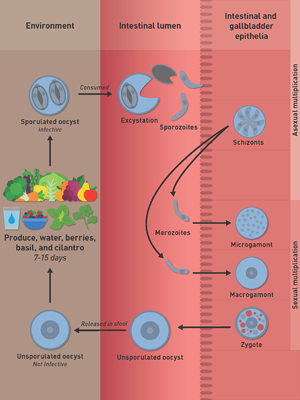Article contents
Transmission electron microscopy on a case of Cyclospora cayetanensis infection from an immune-competent case confirms and extends prior detailed descriptions of its notably small endogenous stage
Published online by Cambridge University Press: 08 June 2022
Abstract

Although infections with Cyclospora cayetanensis are prevalent worldwide, many aspects of this parasite's life cycle remain unknown. Humans are the only known hosts, existing information on its endogenous development has been derived from histological examination of only a few biopsy specimens. In histological sections, its stages are less than 10 μm, making definitive identification difficult. Here, confirmation of cyclosporiasis in a duodenal biopsy specimen from an 80-year-old man without any recognized immunodeficiency patient is reported. Asexual forms (schizonts) and sexual forms (gamonts) were located within enterocytes, including immature and mature schizonts, an immature male gamont and a female gamont. Merozoites were small (<5 μm × 1 μm) and contained two rhoptries, subterminal nucleus and numerous micronemes and amylopectin granules. These parasite stages were like those recently reported in the gallbladder of an immunocompromised patient, suggesting that the general life-cycle stages are not altered by immunosuppression.
- Type
- Research Article
- Information
- Creative Commons
- To the extent this is a work of the US Government, it is not subject to copyright protection within the United States. Published by Cambridge University Press.
- Copyright
- Copyright © United States Department of Agriculture and the Author(s), 2022
References
- 2
- Cited by





